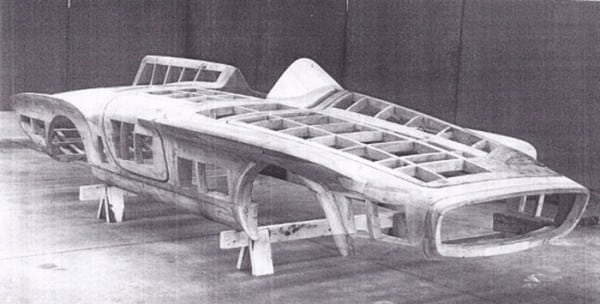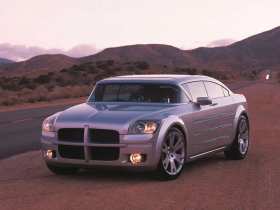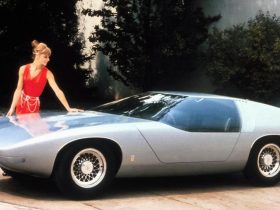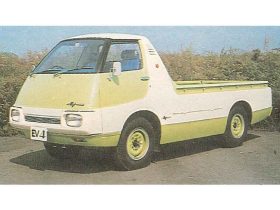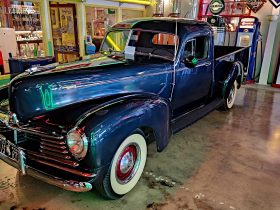The Plymouth XNR concept has several distinctions: it was a one-off concept designed to be purely contrarian, it was designed to be fully operational as a driver’s car, and it has the third-highest value of any auctioned concept car in history. Many other things can also be said about this beautiful and highly unusual concept, which was the product and namesake of automotive design genius Virgil Exner.
Designed For Sport
Chrysler in the post-war years was largely known for staid, practical, and decidedly not-fun vehicles. Much of the company’s reputation was in making pragmatic vehicles that were robust and dependable. The sportiest cars to be offered were under the Plymouth nameplate and they were, frankly, no competition for the Thunderbird and Corvette that Ford and GM were producing.
Despite this button down reputation, Chrysler had a penchant for sending money to Ghia to create concepts for them to showcase. Several of the company’s best concepts of the 1950s and 60s came out of this partnership. The Plymouth XNR is one of those.
The XNR was designed by Virgil Exner, who fits the definition for “automotive design genius” as much as any other to claim the title. Then Chrysler’s design chief, Exner decided that a true sports car to compete with and defeat the other Detroit models would have to be so different that the powertrain would become secondary. In an era when large, wide-bodied, big block muscle was the main claim to fame for Detroit speed, Exner decided to take the road less traveled and do something completely unique.
Less Equals More
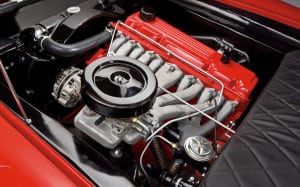 Everything about the Plymouth XNR was to emphasize sportiness. Exner started with a Plymouth Valiant/Dodge Lancer platform and then started making modifications. Rather than the expected big block V8, high-displacement expectation of the day’s sports cars, Exner instead went with a 170 cubic inch slant six engine with a Hyperpak tuned intake, four-barrel carburetor, ported cylinder head, twin-tuned exhaust, and other tuning refinements to get 260 bhp with a top speed of about 152 mph. This was the same basic getup that the compact class Daytona NASCAR racers of 1960 were using and it was a proven way to get a lot of power into a small car.
Everything about the Plymouth XNR was to emphasize sportiness. Exner started with a Plymouth Valiant/Dodge Lancer platform and then started making modifications. Rather than the expected big block V8, high-displacement expectation of the day’s sports cars, Exner instead went with a 170 cubic inch slant six engine with a Hyperpak tuned intake, four-barrel carburetor, ported cylinder head, twin-tuned exhaust, and other tuning refinements to get 260 bhp with a top speed of about 152 mph. This was the same basic getup that the compact class Daytona NASCAR racers of 1960 were using and it was a proven way to get a lot of power into a small car.
To go with the small engine, the design of the Plymouth XNR itself was also small for the time, aiming for light weight and a low profile to match the relatively small engine output.
Asymmetrica
The original conceptual title was Asymmetrica, a very fitting name for the XNR. The entire car is asymmetrically designed around the driver’s seat. Its most prominent and noted feature is the large intake port at the front, on the driver’s side, that expands towards the large driver’s windscreen, interrupted by the open cockpit, then continuing as a rear headrest bulge to narrow to a tall stabilizing fin down the left side of the rear deck. At the rear, this creates a side-laying cross of chrome for the rear bumper.
The front is a large, rectangular oval in chrome inside which an aluminum plate with what we would now call “Denali grille” holes drilled through. Four headlamps, two to each side, mark the car’s visibly unusual face.
Odd fender protrusions hang out over the tires, with an appearance of fins rather than fenders and obviously meant to mark stabilizing forces at speed – whether they worked or not is anyone’s guess. Smaller versions of those fins curve over the rear quarter panels as well. These were an allusion to the Jaguar D-type, which Exner was quite fond of.
The bulge of the intake stops at the dashboard and covers the driver’s instrument panel. That panel contains gauges with camera-like lenses and bezels in front of which a 3-point steel steering wheel clad in wood hangs. Seating is simple, but well-appointed with the driver’s seat, to keep the symmetry uneven, sitting slightly higher than the passenger’s. The windscreens are also asymmetrical on the Plymouth XNR, with the driver’s being large and rounded like a motorcycle screen and the passenger’s being small and rectangular and on hinges so it can fold down when not in use. This creates a streamline look, especially when the passenger’s side is covered – another reason for that seat to be lower.
The Exhaust emerges from behind the left front front tire and runs down the driver’s side of the car, with vented dampers adding class and noise reduction underneath the door along the running boards, to finally quickly curve out just ahead of the rear tire. Heavily chromed wheels with Chrysler’s 3-pronged center caps highlighted are custom to the XNR with unusual interior venting holes. Plymouth and XNR badges adorn the front, rear, and sides of the car, which itself is painted in cherry red.
There is no angle from which the 1960 XNR is not interesting to look at.
History of the Plymouth XNR
After design by Exner and its build by Ghia, the XNR was unveiled in 1960 and made the auto show rounds as a concept showcase of Chrysler’s capabilities. When the company decided not to build it, though, it was returned to Ghia, who technically owned it, at the request of Exner, who knew that if it stayed stateside it would have to be destroyed for liability reasons.
Ghia kept the car on display for a short time and then sold it to a Swiss collector. He in turn sold it to a Persian collector who turned out to be the Shah of Iran. After his fall from power, the car was sold to a Kuwaiti collector and eventually made its way to a Lebanese buyer, who moved it around during the Lebanese war from 1975 to 1991. Another Lebanese collector, Karim Edde, found out that the car was being stored just down the street from his house and made an offer to purchase it. He kept it in hiding until 2008, when he contacted RM Restorations to have the car restored after its long, run-around storage stint.
In 2009, the car went to Canada and began a two-year restoration process. Much of the information for the work was gleaned from Exner’s son, Virgil Exner, Jr., who has retained most of his father’s design portfolio drawings, sketches, notes, etc. and using cover photography from Motor Trend and Road & Track, who’d both featured the car in 1960. Nearly all of the XNR’s original fittings were there. The upholstery was destroyed, the wheel covers were missing, but all of the steel was there and the restoration was mostly about detail and engine work. The hubcaps alone required 35 pieces of machining each.
The car was finished and appeared at the 2011 Amelia Island Concours d’Elegance, where it won its class award. It then went to the 2011 Pebble Beach Concours d’Elegance, taking the Gran Turismo and class awards.
Finally, it was put on the auction block in 2012 by RM Auctions on behalf of Mr. Edde, where it fetched nearly a million dollars – the third-highest price ever paid for a concept car at auction. The Oldsmobile F-88 concept sold in 2005 for $3.24 million to be the highest-valued concept ever while the Desoto Adventurer II concept, also an Exner design, took $1.5 million in 2011.
Most images courtesy of RM Auctions, historical photos from Chrysler and Virgil Exner, Jr.






